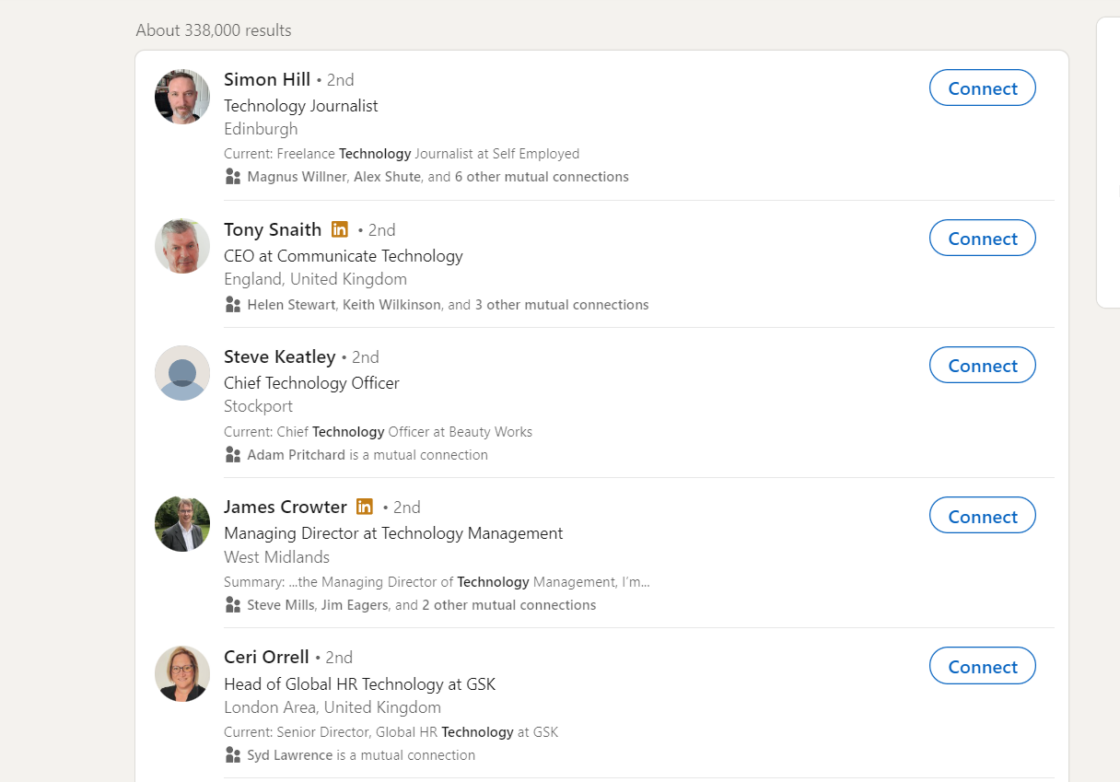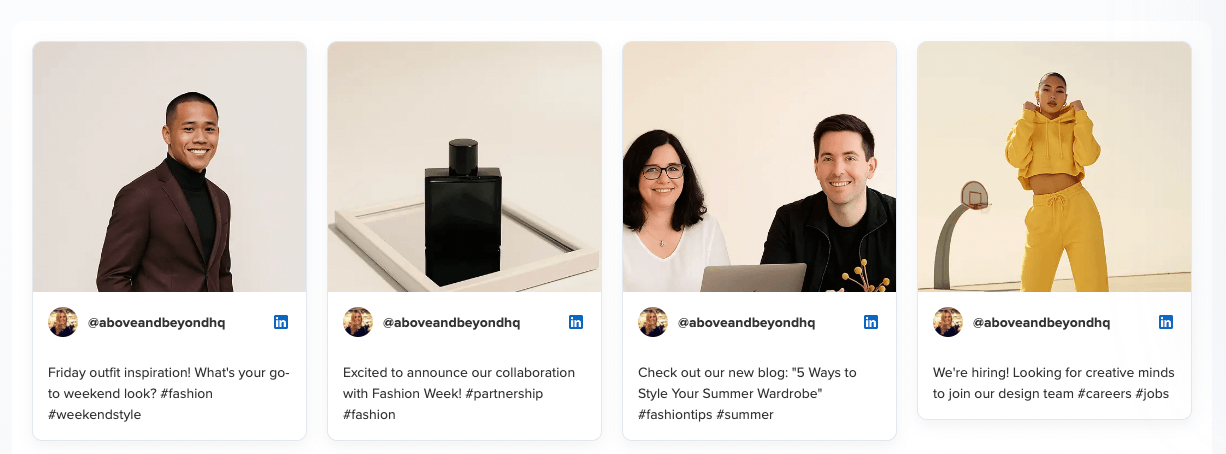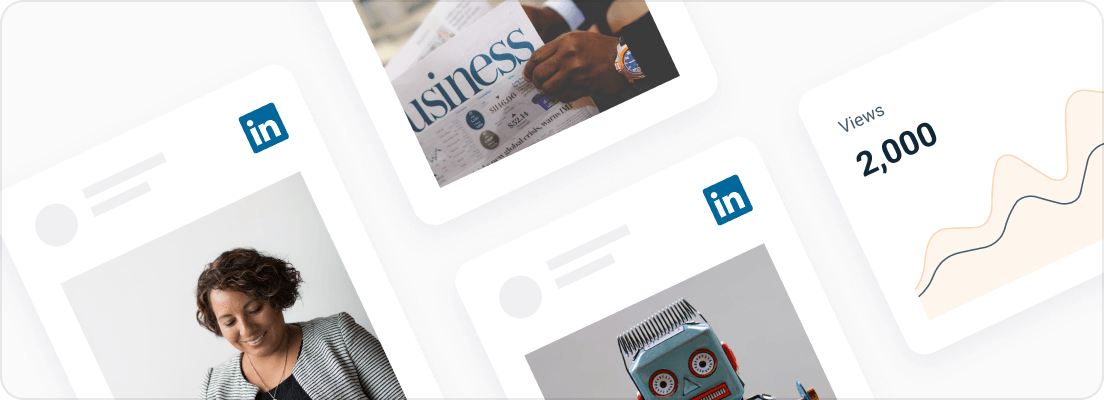Whether you’re a B2B brand seeking to attract new clients or a growing company building your talent pipeline, LinkedIn remains the premier platform for professional growth. While countless B2B companies create and share content with business professionals and potential employees, most still underutilize b2b influencer marketing strategies.
Just like on any other channel, influencers on LinkedIn can significantly improve your brand’s visibility, help you build authentic trust with customers, and drive meaningful sales growth. The good news? You don’t need to spend a fortune on mentions. Micro-influencers account for 91% of the influencer market, and these voices often deliver superior engagement rates compared to their larger counterparts.
Get your complete guide to running effective brand awareness campaigns and leveraging micro-influencers on LinkedIn to B2B marketing greatness.
Why Influencer Marketing is Important on LinkedIn
Recent studies show that working with an influencer can improve customer loyalty by 87% and improve brand awareness by 89%. However, LinkedIn is frequently underestimated as a platform for influencer marketing. Many companies mistakenly assume influencers only drive meaningful results for B2C consumers.
The reality paints a different picture: 78% of B2B marketers who have embraced influencer partnerships report notable increases in sales while simultaneously improving their brand’s reputation and credibility. Recent 2024 data shows that 85% of B2B marketers in the U.S. report using influencer marketing as part of their overall strategy, and 80% of B2B marketers report increased lead generation through influencer partnerships, demonstrating the platform’s continued evolution for B2B marketing. When you implement LinkedIn b2b influencer marketing, these industry leaders and thought leaders assist you in conveying industry insights to business leaders, boost your visibility and impact buying decisions through actual customer interactions. They are even capable of luring top talent toward your firm by emphasizing your distinctive company culture and robust employee value proposition.
Why Use Micro-Influencers on LinkedIn?
So, why micro-influencers? Micro-influencers have a smaller reach than their larger counterparts, usually boasting between 10,000 to 100,000 followers. However, while their reach is smaller, their impact can be just as big or bigger than that of larger influencers.
Studies show that 82% of consumers are likely to buy something a micro-influencer recommends, meaning you still get a great opportunity to boost conversions.
In addition, a micro-influencer with limited followers has inherent strengths that qualify them especially when it comes to using micro-influencers in b2b influencer marketing. They come with low costs such that you can pay affordable prices when using micro-influencers and hence pay for a complete online marketing program when using several micro-influencers at once and staggering your exposure within defined customer segments.
Higher engagement rates represent another key benefit, as micro-influencers maintain more intimate audience relationships. Research shows that micro-influencers achieve engagement rates of around 6%, significantly outperforming mega-influencers who only reach approximately 1.97%.
The ability to reach niche audiences makes micro-influencers particularly effective for B2B campaigns. They target specific, specialized communities, making it easier to connect with B2B buyers or potential employees who are genuinely interested in your business offerings. Finally, enhanced reputation comes from micro-influencers being perceived as more authentic and relatable than celebrity counterparts. They actively engage with comments and maintain genuine online interactions, which positively impact your brand’s reputation through association.
Strategic Implementation: How to Execute Successful Micro-Influencer Brand Promotion Campaigns
The way you approach your strategy for LinkedIn influencer marketing will vary depending on your goals, budget, and other factors. Once you’ve identified and recruited the right micro-influencers, here’s how you can execute and elevate your brand promotion strategy with innovative influencer marketing campaigns on LinkedIn.
Step 1: Define your Goals and Objectives
The first step to using micro-influencers on LinkedIn for B2B marketing is figuring out what you want to accomplish. Your marketing goals will determine what type of influencers you pursue, the content you create, and the audience you target. For instance, you might want to:
- Highlight your employer brand to attract top-tier talent to your team
- Elevate your company’s reputation and establish thought leadership in your industry
- Increase brand loyalty and drive meaningful conversions
- Boost brand awareness and visibility across professional networks
- Generate additional traffic and qualified leads for your B2B company
Decide what the ideal outcome/s of your influencer campaign will be, and define the metrics you’ll use to track the success of your strategy. For instance, if your goal is to showcase your employer brand, you might monitor the increase in job applications. If you want to boost brand awareness, you can monitor social media followers, website traffic, and brand mentions.
Step 2: Validating and Onboarding Your Selected Micro-Influencers
Once you’ve identified potential micro-influencers through your recruitment process (learn more about how to recruit LinkedIn micro-influencers effectively), it’s time to validate and onboard those who will amplify your brand promotion efforts. For instance, if you’re a SaaS company seeking to attract AI tech talent, ensure your selected AI industry authorities truly align with your campaign goals. If you’re promoting new accounting software, validate that your chosen financial professionals and thought leaders have the right audience engagement patterns.
During the validation phase, confirm that your targeted influencer has excellent relationships with your target audience, shares your business values, and can produce frequent, genuine action by their audience.
The great thing about being able to find influencers on LinkedIn is that you can do it easier than most would think. Using LinkedIn’s job post feature, you can post ads for influencers or use the “people” search feature to look for business people talking about something specific, like “Digital Marketing” or “Technology.”

In assessing potential b2b influencers on LinkedIn, search for veteran industry professionals with years of background who post useful insights and more insights regularly, who have developed strong personal brands themselves, and show remarkable expertise in your own field. Seek out influencers who might have written bestsellers, made keynote speeches, or become major authorities in their own right in the B2B arena. Monitor their post frequency, level of engagement, and quality of discussions that they spur in comments. The best micro-influencers exhibit genuine voices while continuously providing actionable business tips to their audience, often reaching their influence across several platforms, such as YouTube channels and other social sites.
An effective method to achieve high response rates is reaching out to influencers via potential 2nd or 1st-degree network connections. In case you believe that it is hard to find micro-influencers from LinkedIn directly, you might want to look at utilizing professional b2b influencer marketplaces and all-encompassing directories like Upfluence or Klear.
Step 3: Develop Your Brand Promotion Content Strategy
Once you identify the best b2b influencer to collaborate with, you then identify content that you would produce. Your b2b influencer can ideally give you recommendations on appropriate content that has been used by them to promote similar brands before, providing sector knowledge that informs procurement decisions.
Or you may have certain types of content you need to showcase, like product reviews, how-to product demonstrations, or company culture tales. To get your micro-influencers to create the most impactful content for LinkedIn, get creative with different types of content like long-form articles of thought leadership that go directly to LinkedIn, informative infographics that communicate detailed insights, interviews with thought leaders from across the industry, and instructive how-to videos.
Create a branded hashtag that can be used by your influencer regularly when promoting your content. This helps to bring in user-generated content while allowing you to get a wonderful opportunity to curate your influencer content throughout your LinkedIn feed plugin for your website.
Provide your influencers with full-fledged resources such as access to professional designing tools, video assets, ready brand collateral, free product demonstrations, and promo codes that influencers can give out to their audience members to increase conversion chances.
Keep in mind, your influencer has likely had extensive experience working on LinkedIn with B2B advertising, so it might be a good idea to give them a great deal of creative latitude and consider their input when developing your campaigns.
Step 4: Execute Brand Storytelling and Relationship-Building Campaigns
One of the biggest advantages of collaborating with micro-influencers is that they already have a relationship with their desired audience base. They are perceived to be extremely genuine and believable, making them great for growing the equity and reputation of your brand.
Capitalise on that by encouraging your micro-influencers to spotlight your brand’s history. Do not simply continuously hard-sell products and product offerings and expect that to go down well with people; challenge your influencers to post informative insights about your company’s values and culture, mission, vision, and objectives.
Extending beyond mere simple promotional bulletins with your LinkedIn influencer campaign will help you bring on more clients and increase your chances of forming more in-depth relationships with large B2B clients.
It’s good to know that B2B consumers often need more evidence that they can trust a company before they consider working with them, so storytelling can be an excellent way to accelerate the B2B purchasing cycle.
Step 5: Amplify Your Brand Promotion Through Cross-Channel Marketing
Once you start posting content with your influencers, don’t just leave the job of driving awareness and visibility to them. Get involved. Share your influencer’s post on your own social media channels, and include links to their top posts in your email newsletter. Reference your influencer in your blog posts and showcase them on your website’s “news” page. If you’re using an influencer for employer brand promotion, you could even post some of their content on your “jobs” page.
Respond to comments on your influencer’s posts to keep the conversation going and increase engagement on LinkedIn, and @mention your influencer frequently.
Another great strategy is to embed your LinkedIn company page or top influencer posts on your website with the help of a social media aggregator. A LinkedIn feed plugin gives you an excellent opportunity to curate all of the best content from one or multiple LinkedIn micro-influencers into a single feed on your website. This acts as yet another form of social proof for your website and can boost your chances of earning conversions when customers arrive on your site. We have a great guide on how to embed a LinkedIn feed on a website with a few easy steps. You can also learn more about profitable reasons to embed LinkedIn on your website.
Step 6: Measure Brand Promotion ROI and Campaign Optimization
Finally, be certain to monitor the results you receive from your LinkedIn influencer campaign. Monitor campaign efficacy by giving each of your influencers trackable links that they can use in their updates to monitor which of your influencers drives the most traffic to your website.
Request that your influencers show their own LinkedIn metrics of engagement and reach for you to get a better idea of what strategies lead you to marketing goals.
You’ll be able to make smart choices when you use LinkedIn for future B2B advertising by having regular tracking metrics in place. The insights you get will help not only your future micro-influencer campaigns but also your own strategies for social media brand promotion.
LinkedIn Influencer Cost and Budget Considerations
Understanding the financial investment required for LinkedIn micro-influencer partnerships is crucial for B2B marketers planning their campaigns. Unlike mega-influencers who can charge thousands per post, micro-influencers typically offer more budget-friendly options while delivering higher engagement rates.
Most LinkedIn micro-influencers charge between $50-$500 per sponsored post, depending on their follower count, engagement rate, and industry expertise. However, many B2B micro-influencers prefer long-term partnership arrangements over one-off posts, which can provide better value and more authentic brand integration.
When budgeting for b2b influencer marketing, allocate 60% of your budget to influencer partnerships, 25% to content creation and design support, and 15% to tracking and analytics tools. This distribution ensures you can maintain quality partnerships while properly measuring ROI and optimizing your digital marketing campaigns for maximum impact. For more insights on influencer marketing costs, check out Influencer Marketing Hub’s comprehensive guide.
Advanced Strategies for LinkedIn Brand Promotion
Beyond basic influencer partnerships, savvy B2B marketers are implementing sophisticated strategies to maximize their LinkedIn brand promotion efforts. Co-created content, where your brand and influencer jointly develop educational resources like whitepapers or webinar series, often generates the highest engagement and lead quality. Learn more about boosting content performance on LinkedIn for additional strategies.
Consider implementing influencer takeovers of your company’s LinkedIn page during industry events or product launches. This approach gives your audience fresh perspectives while positioning your brand at the center of important industry conversations. Additionally, leveraging user-generated content from your influencer partnerships creates authentic social proof that resonates strongly with business professionals making purchasing decisions. According to recent research, LinkedIn is the most effective social media platform for B2B influencer marketing, with 91% of executives using LinkedIn for content, significantly enhancing targeting capabilities and ROI measurement for b2b influencer marketing campaigns.
For maximum impact, develop a content calendar that aligns your influencer partnerships with your broader marketing efforts. When launching new products or services, coordinate with multiple micro-influencers to create a synchronized content wave that amplifies your message across different professional networks. This coordinated approach, often recommended by top B2B marketing agencies, generates significantly higher brand awareness and lead generation than isolated influencer posts, contributing to sustainable business growth and delivering valuable insights that drive long-term success.
Building Long-Term Influencer Relationships
The most successful B2B brands on LinkedIn focus on cultivating lasting relationships rather than transactional partnerships. Long-term collaborations allow leading voices in your industry—including keynote speakers, bestselling authors, and thought leaders with years of experience—to develop a deeper understanding of your brand values and product benefits, resulting in more authentic and effective content promotion that drives measurable business growth.
Invest time in nurturing these relationships by regularly engaging with your influencers’ content, providing exclusive access to company updates, and including them in strategic discussions about industry trends. Consider creating an influencer advisory board where top partners—whether they’re established keynote speakers, industry experts with years of expertise, or emerging thought leaders—can provide more insights on market opportunities and content strategies that resonate with your shared audience. This approach often leads to cross-platform collaboration opportunities, including guest appearances on YouTube channels or joint social media campaigns. Harvard Business Review’s guide on building professional relationships offers additional strategies for cultivating meaningful business partnerships.
How to Leverage Juicer for LinkedIn Influencer Content Amplification
While working with LinkedIn micro-influencers generates valuable content, maximizing the impact of this investment requires strategic content amplification across your digital ecosystem. This is where Juicer, a powerful social media aggregator, becomes an essential tool for B2B marketers looking to extend their influencer partnerships beyond LinkedIn’s native platform.

Understanding Juicer’s Role in B2B Influencer Marketing
Juicer is a comprehensive social media aggregation platform that collects, curates, and displays content from over 15 social media platforms—including LinkedIn—into a unified, customizable feed on your website. For B2B brands investing in LinkedIn influencer partnerships, Juicer transforms individual influencer posts into persistent, discoverable content that continues driving value long after the initial publication.
Unlike traditional social media content that quickly disappears in users’ feeds, Juicer-powered displays ensure your influencer collaborations remain visible to website visitors, creating lasting social proof that supports conversion optimization and brand credibility. This approach is particularly valuable for B2B sales cycles, where prospects often require multiple touchpoints and extensive research before making purchasing decisions.
Key Benefits of Using Juicer for LinkedIn Influencer Content
Enhanced Social Proof and Credibility
When potential clients visit your website and see authentic endorsements from industry thought leaders, keynote speakers, and respected professionals displayed prominently, it significantly impacts their purchasing decisions. Juicer automatically pulls your influencer content, creating a dynamic testimonial wall that updates in real-time.
Extended Content Lifespan and ROI
LinkedIn posts typically have a 24-48 hour engagement window. By embedding these posts on your website through Juicer, you extend their visibility indefinitely, maximizing the return on your influencer marketing investment. Visitors can discover valuable insights from your influencer partnerships months after the original publication.
Improved Website Engagement and Dwell Time
Fresh, relevant content from industry experts keeps website visitors engaged longer, reducing bounce rates and improving SEO performance. Juicer’s automatic content updates ensure your website consistently features the latest insights from your influencer network.
Streamlined Content Curation
Rather than manually selecting and uploading influencer content, Juicer automatically aggregates posts based on your specified criteria, saving time while ensuring consistent content quality and relevance.
Discover the Benefits of LinkedIn Influencer Marketing
LinkedIn influencer marketing can be an incredible way to boost your access to new leads and traffic, improve your brand’s reputation, and unlock sustainable business growth opportunities. Research shows that B2B influencer marketing campaigns deliver a 520% return on investment, making it one of the most effective marketing strategies available. With micro-influencers—including established thought leaders, keynote speakers, and marketing experts—you can access valuable insights and authentic brand promotion without the unnecessary expense of working with a major celebrity or top B2B marketing agency rates.
Don’t forget to take full advantage of your influencer relationship, too, by using tools like Juicer’s LinkedIn aggregator to showcase your top-performing influencer posts on your website. This approach can help with personal branding for B2B while building stronger professional relationships. Get started with the Juicer LinkedIn Feed plugin here.





